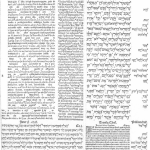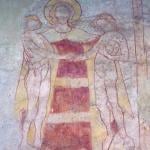Last updated on: July 18, 2015 at 6:03 pm
By
CNA Daily News
Vatican City, Jul 18, 2015 / 12:03 pm (CNA/EWTN News).- Continuing his theme on protecting both the environment and human rights, Pope Francis pointed to various injustices in the mining industry and called for collaboration in fostering change. All involved in the field of mining “are called upon to adopt behavior inspired by the fact that we constitute a single human family, everything is interconnected,” Francis said July 18. He stressed that genuine care for our own lives and our relationship with nature is “inseparable from fraternity, justice and faithfulness to others.” The Pope made his comments in a message sent to participants in a July 17-19 conference titled “United to God, We Hear a Cry,” organized by the Vatican’s Council for Justice and Peace and the Latin American “Churches and Mining” network. Held at Rome’s Salesianum Congress Centre, the meeting gathers community leaders, laborers and families involved in and affected by the mining industry. The event featured testimonies from those who have suffered first hand from corruption and torture. Mining was a subject Francis also touched on in his recent encyclical on the environment, “Laudato Si,” released June 18. In his message, Pope Francis noted that there are many communities, families and individuals who frequently suffer both directly and indirectly due to the “too often negative” consequences of mining activities. The conference, he said, represents “a cry for lost land; a cry for the extraction of wealth from land that paradoxically does not produce wealth for the local populations who remain poor; a cry of pain in reaction to violence, threats and corruption.” He said it also gives voice to the “cry of indignation and for help for the violations of human rights, blatantly or discreetly trampled with regard to the health of populations, working conditions, and at times the slavery and human trafficking that feeds the tragic phenomenon of prostitution.” Francis also pointed to the frequent contamination of the water, air and land, and the cry of “incomprehension for the absence for inclusive processes or support from the civil, local and national authorities, which have the fundamental duty to promote the common good.” The Pope made an “urgent appeal” for collaboration in fighting environmental degradation and fostering an “integral, inclusive” sustainable development. He called on governments in countries where mining takes place, suppliers, business leaders and investors to hold multinational mining companies to a socially responsible behavior. “The entire mining sector is undoubtedly required to effect a radical paradigm change to improve the situation in many countries.” Cardinal Peter Turkson, president of the Pontifical Council for Justice and Peace, spoke with journalists July 17 about the closed-door meeting, saying that we cannot remain indifferent to both “the cry of the earth and the cry of the poor” highlighted by Pope Francis in his encyclical “Laudato Si.” In 2013 the council organized a similar conference titled “Mining for the common good,” which was followed up by a report handed out to the various episcopal conferences involved. This week’s meeting serves as a preparation for a second conference titled “Creating a new future, Reimaging the future of mining,” scheduled to take place in September. “Many of us are aware of this harrowing cry from those areas where mineral extraction is carried out,” the cardinal said, and pointed to various reports informing on the status of the rights of indigenous populations and legislation on mineral traceability currently being developed by the European Parliament. He also pointed to the portrayal of these injustices seen in films such as “Blood Diamond” and “Avatar.” “Faced with these situations, we cannot allow indifference, cynicism and impunity to continue to prevail. A radical paradigm change is needed in the interests of the common good, justice, sustainability and human dignity,” he said. Cardinal Turkson pointed to various stories the council has received of “threats, violence and murder; of retaliation, of compensation never received, and of un-kept promises.” Among them is the story of Héritier Wembo Nyama from the Democratic Republic of the Congo, who was present alongside the cardinal and four other members of the mining sector. Wembo recalled how he was set on fire by local police during a protest against a mining company. After then being arrested, tied up and tortured, it took him a two-week stay in the hospital to recover. He said he was tracked down and threatened while in Kigali waiting to come to Rome. “They said they’d kill me if I came,” he said. Other instances recounted by participants from Chile, Brazil and India revealed stories of activists in popular movements that had been killed for opposing mining activities in their communities, as well as those of water pollution, environmental degradation and various other negative effects of mining. Read more
















